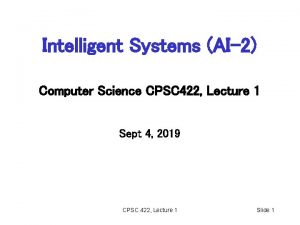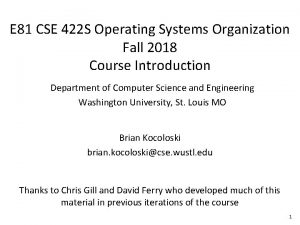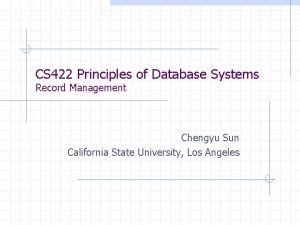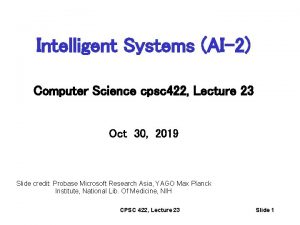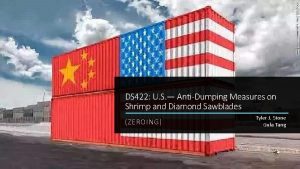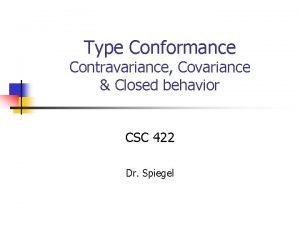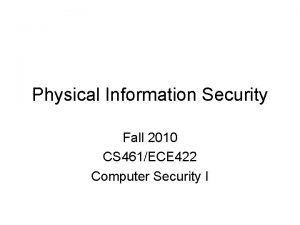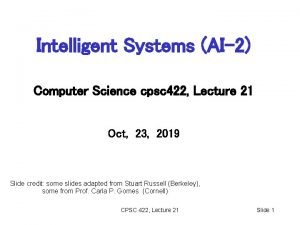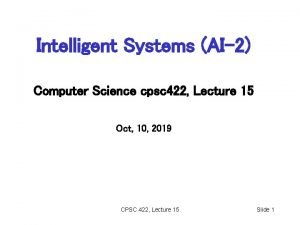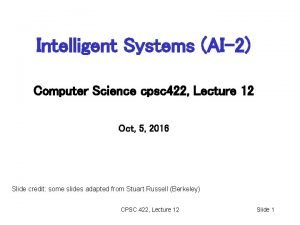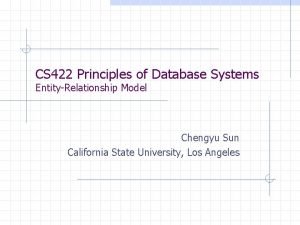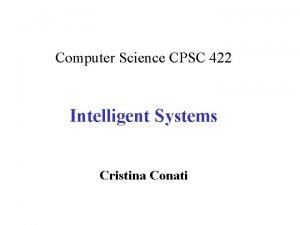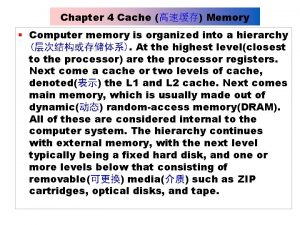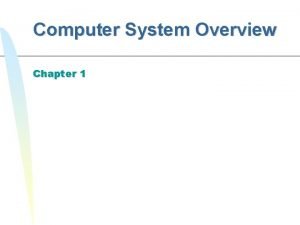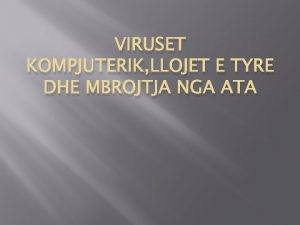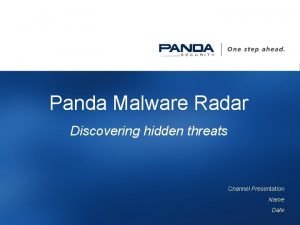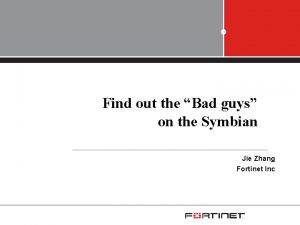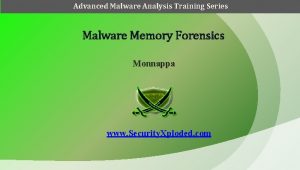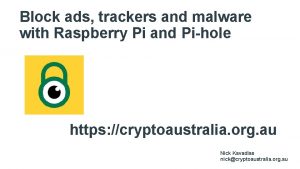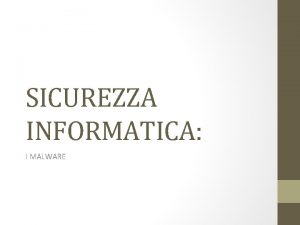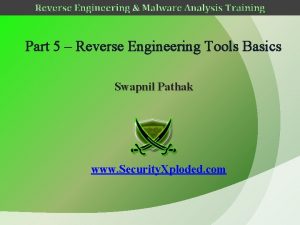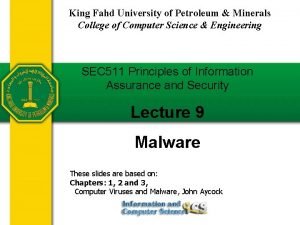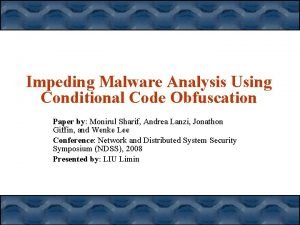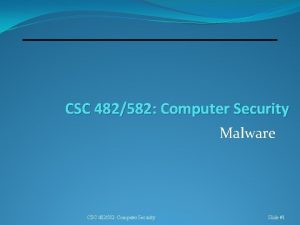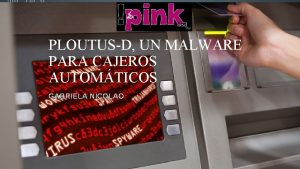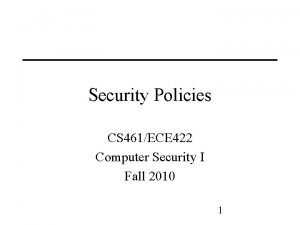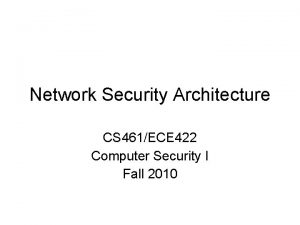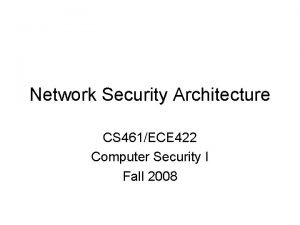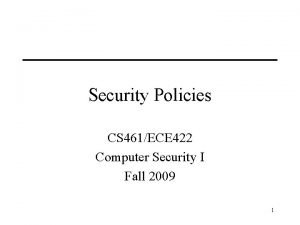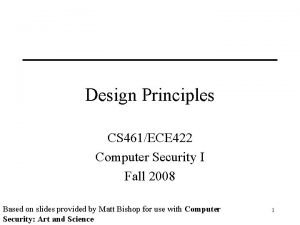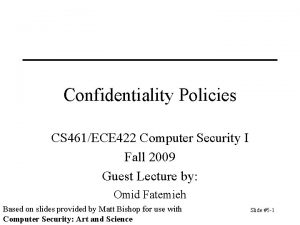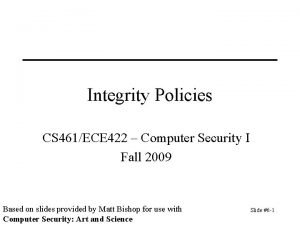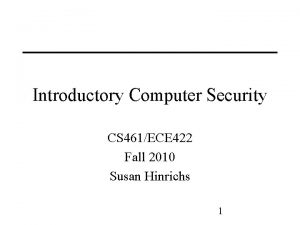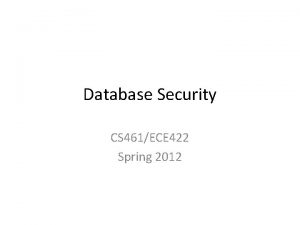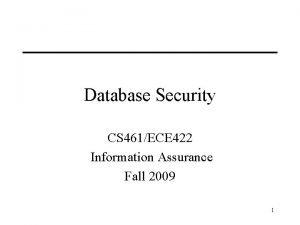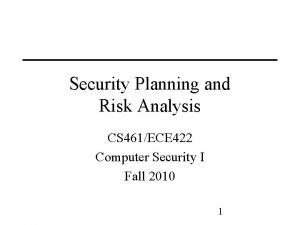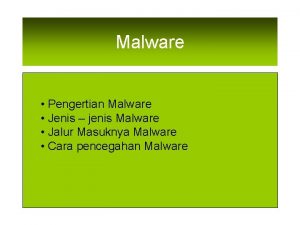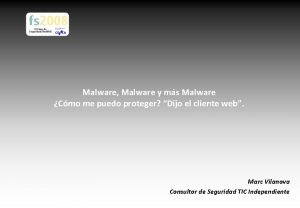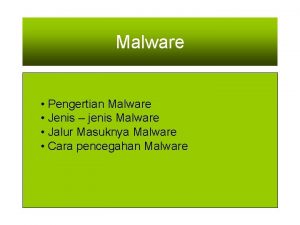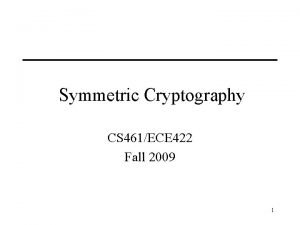Malware Overview Computer Security I CS 461ECE 422









































- Slides: 41

Malware Overview Computer Security I CS 461/ECE 422 Spring 2012

Reading Material • Chapter 6 of text • Ken Thompson and Trojans – http: //cm. bell-labs. com/who/ken/trust. html • Worm Anatomy and Model http: //portal. acm. org/citation. cfm? id=948196

Outline • Malware – Trojans, rootkits – Virus – Structure – Prevention – Worm – Structure – Prevention

Zero Day Exploit • An exploit that has no patch available • Time between exploit discovery and wide activation shrinking • Malware developer has trade-off – Big splash but faster discovery – Reduced attack rate but longer undiscovered

Windows Meta File Exploit • Exploit flaws in the Windows rendering engine enable remote code execution – Memory corruptions – Visiting web site with “bad image” causes attack – Drive-by download – Attack sold for $4, 000 – http: //www. eweek. com/article 2/0, 1895, 1918198, 00. asp • Bugtraq post in December 2005 – Probably lingering earlier – 0 day exploit • Microsoft’s response in early January 2006 – http: //www. microsoft. com/technet/security/bulletin/ms 06001. mspx

Malicious Code • Set of instructions that cause a site’s security policy to be violated • Often leveraging an inadvertent flaw (design or implementation) – To propagate/install on target – To cause harm on target

Malware Summary

Trojan Horses • Seemingly useful program that contains code that does harmful things – Perform both overt and covert actions • Frequently embedded in applets or games, email attachments (mafia wars? ) • Trojan horse logins, spoof authentication or webpage forms

Thompson's Trojan Compiler • Infect it in compiling “login” program – Add “bug” to accept fixed password • Problem: – Easily seen in code review • Solution: – Add second bug activated when compiling compiler itself – Then remove bugs from source • http: //cm. bell-labs. com/who/ken/trust. html

Rootkits • Replace function table entries. • New version performs extra checks to hide information before performing original call. • Can replace Windows API pointers (user mode) • Can also replace syscall table pointers • Both require privilege, but most Windows installs require privilege anyway • Techniques apply equally well to Linux and Mac

Rootkit Infiltration

Rootkit Countermeasures • Hard to defend/detect • User mode - Look for discrepancies • Between results of different APIs • Between API results and direct access to storage • E. g. , Rootkit revealer from Sysinternals (now MS)

Sony Player DRM and Rootkits • Bad press for Sony 2005 – Mark Russinovich's original observations http: //blogs. technet. com/markrussinovich/archive/2005/10/31/son y-rootkits-and-digital-rights-management-gone-toofar. aspx#comments – A timeline – http: //www. boing. net/2005/11/14/sony_anticustomer_te. html • To ensure that copy protection is not evaded install rootkit to hide the protection code – – Available for other attackers to use Un-installable Uses CPU and memory Not adequately noted in EULA

Virus Parts • Infection mechanism • How the virus moves from victim to victim • Trigger • The condition that causes the payload to activate or be delivered • Payload • The activity of the virus beyond the spreading • E. g. , installing software, harvesting information

Virus Operation • Virus Phases: – Dormant: Waiting on trigger event – Propagation: Replicating to programs/disks – Triggering: By event to execute payload – Execution: Executing payload • Details usually Machine/OS specific – Exploits different features or weaknesses

Virus Pseudocode • beginvirus: • If spread-condition then begin – For some set of target files do begin • If target is not infected then begin – Determine where to place virus instructions – Copy instructions from beginvirus to endvirus into target – Alter target to execute new instructions • If trigger pulled • Perform some actions • Goto beginning of infected program • endvirus:

Virus Attachment • A Virus can attach itself to a program or to data by – Appending itself to either the beginning or end of either source code or assembly, so it is activated when the program is run – Integrate itself into the program, spread out code – Compress original program so addition of virus does not change file system – Integrate into data: executable text macro, scripting – Macros and email attachments • An activated virus may: – Cause direct or immediate harm – Run as a memory resident program (TSR, daemon, or service) – Replace or relocate boot sector programs, start at system startup

Macros Viruses • Macro code attached to some data file – Interpreted rather than compiled – Platform independent – Mobile code • Interpreted by program using the file – E. g. , Word/Excel macros – Esp. using auto command macros – Often automatically invoked • Blurs distinction between data and program files making task of detection much harder • Classic trade-off: ”ease of use” vs ”security”

Email Viruses • Spread using email with attachment containing a macro virus – Melissa, Love. Bug • Triggered when user opens or executes attachment – Also when mail viewed by using scripting features in mail agent – Usually targeted at Microsoft Outlook mail agent and Word/Excel documents, Microsoft IIS

Basic Precautions • Don’t import untrusted programs – Who can you trust? – Viruses have been found in commercial shrink -wrap software – Standard download sites have been corrupted • Check MD 5 hashes • Scan for viruses, install anti-virus software • Update anti-virus software regularly

Signature Scanning • Early viruses had characteristic code patterns known as signatures • Create a database of patterns, search files for patterns (Mc. Affee) • Use data-mining, learning, feature extraction etc. to look for disguised or obfuscated patterns • Can only scan for known signatures • Text calls this “first generation” scanner

Signature Avoiding Viruses • Polymorphic Virus produces varying but operationally equivalent copies of itself – Use alternative but equivalent instructions – Gets around signature scanners. Whale virus, 32 variants • Stealth Virus actively tries to hide all signs of its presence – A virus can intercept calls to read a file and return correct values about file sizes etc. Brain Virus

Another Signature Avoiding Virus • Encrypted Virus stores bulk of self encrypted – Small decrypt routine in clear – Key stored in clear – Metamorphic virus: mutates with every infection – Similar to polymorphic – But this is a complete rewrite

Other Virus Scanners • Second generation • Use heuristics rather than direct signatures • Look for code fragments like encrypt/decrypt loops • Use integrity checks to track changes • Third generation • Track virus by actions rather than code • Identify/notify/prevent anomalous behaviour • E. g. , installing device driver after visiting a web site • E. g, Cisco Security Agent. Host based intrusion detection. Behaviour blocking software discussed in text.

Other Virus Scanners • Fourth Generation • Use multiple techniques • Scanning • Access control • Behavioural analysis

Virus Scanners v. Malware What percentage of new viruses does a virus scanner detect?

Worms • Propagate from one computer to another – Self-directed propagation • Viruses use email/infected media to propagate to so differentiation is fuzzy

The Morris Worm Incident • How 99 lines of code brought down the Internet (ARPANET actually) in November 1988. • Robert Morris Jr. Ph. D student, Cornell, wrote a program that could: – Connect to another computer, and find and use one of several vulnerabilities (buffer overflow in fingerd, password cracking, backdoor in mail program) to copy itself to that second computer. – Begin to run the copy of itself at the new location. – Both the original code and the copy would then repeat these actions in an infinite loop to other computers on the ARPANET (mistake!) • Morris was sentenced to three years of probation, 400 hours of community service, and a fine of $10, 050. (He is now a Professor at MIT. ) • Worms have gotten bigger and more aggressive

Worm Phases • Dormant • Propagation – Search for other systems to infect – Establish connection to target remote system – Replicate self onto remote system • Triggering • Execution

Who to target? • Scanning – Currently generally used – Select random addresses • Mix of addresses in current network (local computers probably have similar vulnerabilities) and remote networks – No longer feasible in IPv 6 • 32 bit vs 128 bit address space

Viruses and Worms in IPv 4 • Slammer infected most of the IPv 4 Internet in 10 minutes (75, 000 hosts infected in one-half hour) Source caida. org

Worms in IPv 6 • Address space is 2^128 instead of 2^32 – Random address selection will not work • Say ¼ of address in IP 4 network run Windows (2^30) – 1 in 4 chance of finding a target with each probe • Spread that among 2^128 addresses – 1 in 2^98 chances of finding a viable target

Viruses and Worms in IPv 6 • Pure Viruses don’t change in IPv 6 but hybrid and pure worms do. – Hybrids and pure worms today rely in Internet scanning to infect other hosts, this isn’t feasible as shown earlier in this presentation. – At 1 million packets per second on a IPv 6 subnet with 10, 000 hosts it would take over 28 years to find the first host to infect – Let’s take a look at the same animation this time simulating how slammer might fare in an all IPv 6 Internet: 28 Years Later • Worm developers will adapt to IPv 6 but pure random scanning worms will be much more problematic for the attacker. Best practices around worm detection and mitigation from IPv 4 remain.

Other Techniques to Find Targets • Interesting Papers – How to 0 wn the Internet… http: //www. icir. org/vern/papers/cdcusenix-sec 02/ – Top speed of flash worms http: //www. caida. org/publications/papers/2004/topspeedworms/t opspeed-worm 04. pdf • Hitlist Scanning – Stealthy scans (randomized, over months), distributed scanning, • DNS searches, Spiders (Code red, crawls for high connectivity), listening on P 2 P networks, public lists • Permutation scanning (divide up IP address space) • Warhol worm- Hit list + permutation

Network Propagation • Send small number of packets to reduce detection • UDP packets – No ACK needed, so can spoof source address • Connect to vulnerable network services – Generally exercise buffer overflow – Launch shell • Running at high privilege (ideal) • Or use as foothold to mount other attacks to gain privilege • Or use as attack launch point

Worm Examples • Morris Worm • Code Red – – Exploited bug in MS IIS to penetrate and spread Probes random IPs for systems running IIS Had trigger time for denial-of-service attack 2 nd wave infected 360000 servers in 14 hours • Code Red 2 - trapdoor, for remote control • Nimda - used multiple infection mechanisms, email, file-sharing, web-client, IIS, Code Red 2 backdoor

More Worm Examples • SQL Slammer • Buffer overflow in MS SQL Server • Infected 90% of vulnerable hosts in 10 minutes • Conficker • Attacks windows systems to install botnet software • Password attacks and MS network vulnerabilities

Botnets • Install on compromised machines • Master sends commands to bots – Originally communicate through IRC – DDo. S, large distributed computing, spam – Now user more sophisticated P 2 P control nets – Changing domain names • Stable framework to create your own botnets – http: //www. egghelp. org/ – http: //www. energymech. net/

Drive-by Infections • Much malware installation (e. g. netbots) in caused by user-instigated drive-by download • Visit infected web site and accidently download software (like the windows meta file exploit) • Click link to view cute “Dancing bunny” e-card your friend sent you • Less is caused by direct worm-style network propagation • Improved network controls

Worm Controls • Signature based scanning • Filter-based worm containment • Payload-classification • Packet analysis. More than just scanning • Threshold random walk • Look for randomness in communication patterns • Rate limiting • Limit the amount of scan-like traffic per host • Rate halting • Stop host after limit is reached

Key points • Malware is real – Propagation – Attack – Control – Malware evolves – Technology – Motivations
 Static malware analysis vs dynamic malware analysis
Static malware analysis vs dynamic malware analysis Private securty
Private securty Asvs assessment
Asvs assessment Android security overview
Android security overview A library has 6 422 music cds stored on 26 shelves
A library has 6 422 music cds stored on 26 shelves Cpsc 422
Cpsc 422 Cse 422
Cse 422 Cs 422
Cs 422 Af from 422
Af from 422 Rounding hundred thousands
Rounding hundred thousands Round 598 500 to the nearest ten thousand
Round 598 500 to the nearest ten thousand Cpsc 422
Cpsc 422 422
422 Ds 422
Ds 422 Csc 422
Csc 422 Cs 422
Cs 422 Uiuc cs 461
Uiuc cs 461 Cpsc 422
Cpsc 422 Cpsc 422
Cpsc 422 Cpsc 422
Cpsc 422 Cs 422
Cs 422 Hajir roozbehani
Hajir roozbehani Computer memory system overview
Computer memory system overview Computer memory system overview
Computer memory system overview Computer system overview
Computer system overview Mbrojtja e kompjuterit
Mbrojtja e kompjuterit Rhmd: evasion-resilient hardware malware detectors
Rhmd: evasion-resilient hardware malware detectors Malware radar
Malware radar Ddos tabletop exercise
Ddos tabletop exercise Bad guys mdl
Bad guys mdl Memory forensics training
Memory forensics training Misp malware
Misp malware Wat is malware
Wat is malware Best pihole adlists 2020
Best pihole adlists 2020 Malware, nella sicurezza informatica indica
Malware, nella sicurezza informatica indica Malware reverse engineering training
Malware reverse engineering training Bomb cryptor
Bomb cryptor Malware analysis
Malware analysis Unlabel
Unlabel Type de malware
Type de malware Apatedns
Apatedns Ploutus-d
Ploutus-d





